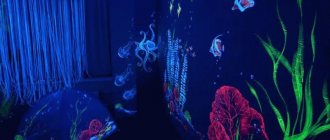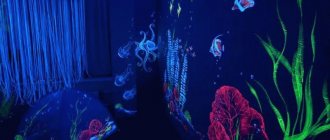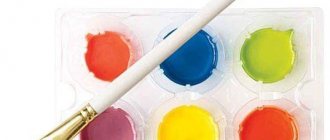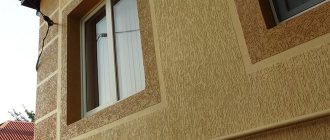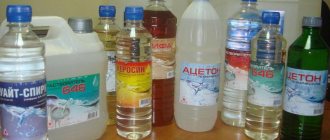Types of luminous paints
To determine the name of the paint that glows in the dark, it is enough to find out what luminescent component is included in its composition:
- Fluorescent enamels. Painted surfaces glow when exposed to ultraviolet radiation. When the UV lamp is turned off, the effect disappears. Fluorescent compositions are made on the basis of acrylic varnish that is safe for health. They are usually used to decorate the interiors of nightclubs, cafes, and building exteriors. Bright combinations of pink, yellow, red, green tones give a magnificent lighting effect.
- Luminescent (phosphor) paints. They are created on the basis of phosphors. To glow for 8-12 hours, it is enough for the painted surface to be under bright light for 20 minutes. The energy source can be either artificial or natural lighting.
- Reflective paints. Painted surfaces begin to glow when light shines on them. Paints are usually used for marking road surfaces and industrial areas, painting road and warning signs, and marking the boundaries of areas. They are made on the basis of enamels.
- Phosphorescent paints. They contain phosphorus, which is dangerous to humans. These compounds are not used for interior work - only for exterior design, car tuning and facade finishing.
Painting with fluorescent paints
Often luminous paintings are created based on an existing wall painting, resulting in an unexpected fairy-tale effect.
But sometimes designers apply a design with fluorescent paints on a plain surface. During the day it is an ordinary wall, but at night a fantastic picture appears on it. This finishing material is applied in various ways:
- brush;
- roller;
- aerosol.
By purchasing fluorescent (neon) pigment and mixing it with clear varnish, you can save money.
Application area
Luminescent compounds are widely used in various fields:
- Artistic painting of interiors. Using luminous enamels, they create original paintings on walls, ceilings and floors.
- Decoration of furniture, paintings, vases and other interior items.
- Floristry: designing compositions from fresh and artificial flowers.
- Decoration of stage and advertising clothing, shoes, backpacks and bags, as well as clothing for road and emergency services workers. The luminous coloring withstands a large number of washes.
- Glowing makeup and body art. They use water-based acrylic compounds that are safe for health.
- Decoration of advertising and souvenir products: signs, posters, stickers, posters, etc.
- Decoration of cars and bicycles: drawings on bodies, decoration of spokes, rims, frames, bicycle helmets.
- Landscape design: design of facades, gazebos, verandas, fences, various decorative elements.
Scope of use
Luminescent paint is used in different areas:
- in decorative finishing of restaurants, cafes, night clubs;
- for painting various furniture, for example, chairs, tables, sofas;
- when creating makeup elements, theatrical costumes, and various stage attributes;
- in flower compositions – both artificial and real;
- in the textile industry, for creating designs, logos and other elements on clothing;
- for painting various wooden structures, for example, outdoor gazebos, window frames, exterior items;
- in tuning bicycles, motorcycles and cars;
- in the manufacture of special services clothing;
- in the production of road markings and signs.
Today, luminous paints are often used for decorative decoration of premises. This dye can be applied to walls, ceilings, as drawings or patterns; they will only appear at night when the lights are off. Many designers advise using different colors of luminescent paint to create an original, attractive interior design at home.
Composition and transparency
To produce a luminescent composition, luminescent pigments are mixed with various carriers. The most commonly used are clear acrylic varnish or polyurethane-based varnish. The composition of the varnish does not affect the quality of the glow, but the durability and scope of application of the enamel depends on it.
High-quality enamels are non-toxic - they can even be used to decorate children's rooms. Compositions based on phosphors are used for external and internal work. Phosphors are resistant to high and low temperatures and adverse weather conditions. Painted surfaces retain their ability to glow for many years.
Luminescent enamels can be translucent and colored
Translucent ones are almost invisible in daylight. In the dark they glow blue or green.
Colored ones are visible both in the dark and in light. Many enamels contain not only phosphors, but also fluorescent components, so they glow under ultraviolet light.
The scope of application of paints depends on their components:
- Enamels based on polyurethane resins are used for plastics and PVC. They have high adhesive properties.
- For application to flowers, makeup and body art, compositions made on the basis of a harmless water-acrylic dispersion are used.
- Enamels with polyphenyl components have high heat resistance. They are used to decorate metal and glass surfaces.
- Compositions based on water-repellent varnish are used for painting pools and bathtubs.
Luminescent paint
Luminescent paint is a substance that has a special effect. Using it, we can solve several problems at once. The painted layer is a barrier between the base and the microclimate of the room. In other words, the characteristic “aromas” that primer and plaster compositions possess will not enter the room. Dust will not be generated, which usually occurs during construction work.
The surface to be painted will be reliably protected from humidity and temperature changes. Processing and caring for such surfaces will not be difficult. You can carry out wet processing using chemicals.
Modern paints and varnishes can give the surface to be painted any microtexture. The main direction is to give the sample a beautiful appearance. You can get a smooth or rough effect. And if we talk about color, there are simply endless possibilities. Modern technologies in the production of paints and varnishes even make it possible to create a pearlescent video effect. Such a coloring substance is capable of changing the color background depending on the brightness of the light flux. This special effect can be achieved thanks to the special additives contained in the composition. The surface coating method has an influence.
The use of multi-color paints and varnishes makes it possible to obtain a spot image. The result is a unique pattern with unique colors.
Well, a completely new direction in the world of paints - a coloring material with a luminescent effect.
Translated from Greek, phosphor is a composition that carries light. The uniqueness of the material lies in its ability to transform absorbed light energy into a luminous stream. This is the main difference between luminescent paints. And most importantly, they do not contain toxic substances that are present, for example, in phosphorus paints.
Luminescent paints are used mainly to create luminous inscriptions on items of clothing, shoes, and student bags. You can’t do without these paints when producing advertisements, souvenirs, and Christmas tree decorations. One of the new areas for using such paints is makeup or body art. Special mixtures have been created that are safe for humans and can be applied to the skin.
The glow of luminescent paint is observed in the dark due to ultraviolet rays absorbed during the day.
If you look carefully, you can say that adding phosphor powder to ordinary varnish or paint gives a glowing effect. Elements of the lanthanide group and aluminum oxide are capable of activating the glow.
Various materials can be treated with luminescent paint. Almost all surfaces that surround us at home and on the street can be painted with this paint. Moreover, in addition to uniqueness, painted materials increase functional characteristics. The release form of such paints is different - you can buy it in a can, or you can find it in a spray - it all depends on where you will use it.
Features of luminous paint
The glow of paint occurs due to the presence of toxic substances in it. Therefore, when choosing paint, you need to pay attention to the availability of quality certificates.
The color of the composition does not always match the shade of its glow in the dark, so when purchasing, you need to read the instructions.
Many manufacturers indicate the glow period of enamel from 20 to 30 years. In practice, the paint often stops glowing much earlier. This is due to the fact that the loss of glow intensity began to decrease long before purchase. Pay attention to the expiration date of the composition.
Self-made luminous compositions may be of low quality and harmful to health, so it is better to buy ready-made paint from well-known manufacturers.
Operating principle
Any object or surface that is painted with luminescent paint begins to glow as evening falls or when the lights are turned off. These dyes are sold in many stores; they can be called fluorescent, phosphor or luminescent dyes.
Throughout the day, when it is light in the room or outside, this paint accumulates light energy, and when it becomes dark, the dye begins to emit the accumulated light. The cyclical nature of this action continues for many years. Glowing paint has such unique properties thanks to special pigments called phosphors. This is a powdery composition that has stable chemical properties; paints are made from this powder. Glowing paints are produced by mixing phosphor with transparent or colored varnish.
Important! The phosphor can be used for 30 years or more. It can be used both for internal, interior finishing work, and for external, facade finishing, outdoors.
Application methods
You can apply luminous paints in the following ways:
- For application it is most convenient to use a spray can. This will allow you to evenly distribute the enamel over the surface. Compositions with a thick consistency can be applied using a brush or roller.
- The surface to be painted must be thoroughly cleaned and dried.
- The greatest brightness of the glow is achieved on a white base, so the material to be painted is usually primed.
- Before painting, shake the can of enamel, since the phosphor often precipitates.
- The second layer is applied only after the first has completely dried.
- When working with phosphorus paints, you must take precautions: spray the composition with rubber gloves, use a respirator and safety glasses. The room must have good ventilation.
Applying neon paint to a surface: effect in the dark
This material is based on an acrylic binder.
Therefore, water is suitable as a diluent, and a special distillate is suitable for spray guns. When applied, the composition dries quickly, resulting in a durable film. Application Tips:
- you need to work in a warm, well-ventilated area;
- use rubber gloves, safety glasses, respirator;
- for adhesion, the paint is applied to a clean, dry surface, which should preferably be treated with a primer made of acrylic copolymers;
- to immediately monitor the result, the room should be dark and the UV light should be turned on;
- The treated surface should be dried with good ventilation, but without drafts.
DIY making
Making phosphor paint with your own hands is not difficult. To do this, use a ready-made phosphor, solvent and varnish suitable for the surface to be painted. The phosphor can be purchased at hardware stores or online. Its cost depends on the intensity of the glow: the lighter it is, the cheaper the composition.
Sequencing:
- Pour the varnish into a glass or porcelain bowl
- Add 15 to 50 percent phosphor. The brightness of the glow will depend on its quantity. The optimal proportion is 30% luminous pigment to 70% varnish.
- To ensure that the phosphor is evenly distributed in the varnish, add a solvent (no more than one percent) and mix the paint thoroughly.
- The prepared composition will be transparent, but it can be tinted with the desired color.
The resulting enamel should be used and stored in the same way as the varnish on which it is made.
How to make glowing paint at home?
Preparing phosphor at home is not difficult at all. To do this, you need to purchase pine concentrate, which can be bought at the pharmacy. Pour or pour (if the substance is liquid) the concentrate into the container.
Then add a small amount of water. Thus, we obtain liquid tartrazine.
Tartrazine is a synthetic dye with a characteristic yellow color. It belongs to food.
Then mix the entire resulting mass thoroughly until smooth. Place the bowl with the mixture on the fire and heat it. When heated, air bubbles form, which need to be pierced with a sharp object.
The next step is to cool the mixture, add tartrazine again and heat it up. After completing the procedure, a homogeneous yellow substance is obtained.
To check the result, the resulting mass must be illuminated with a bright flash. If everything is done correctly, the glow will be noticeable. The resulting phosphor substance can be crushed into powder by crushing it.
You can learn more about the process in the thematic video.
Recipe for improved phosphor:
